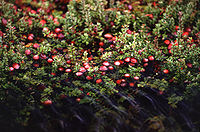
Photo from wikipedia
Antioxidant dietary fiber extracted from spent coffee grounds (FSCG) was evaluated as a potential functional food ingredient when incorporated in a food model (biscuits), and digested in vitro under simulated… Click to show full abstract
Antioxidant dietary fiber extracted from spent coffee grounds (FSCG) was evaluated as a potential functional food ingredient when incorporated in a food model (biscuits), and digested in vitro under simulated human gastrointestinal conditions. FSCG added to biscuits increased its total dietary fiber, antioxidant capacity after in vitro digestion, bioaccessibility of phenolic compounds (gallic acid and catechin) and amino acids. Furthermore, advanced glycation end products (AGEs), involved in chronic diseases, decreased up to 6-folds in the biscuits containing FSCG when compared with the traditional biscuit. The digestible fraction of biscuits containing the highest amount of FSCG (5 g) displayed the higher inhibiting α-glucosidase activity, correlating with the bioaccessibility of ascorbic acid and catechin. Our study seems to indicate that anti-diabetic compounds may be released in the small intestine during FSCG digestion, where biscuits containing FSCG may be able to beneficially regulate sugar metabolism thereby helping in producing foods friendly for diabetes.
Journal Title: Food chemistry
Year Published: 2018
Link to full text (if available)
Share on Social Media: Sign Up to like & get
recommendations!